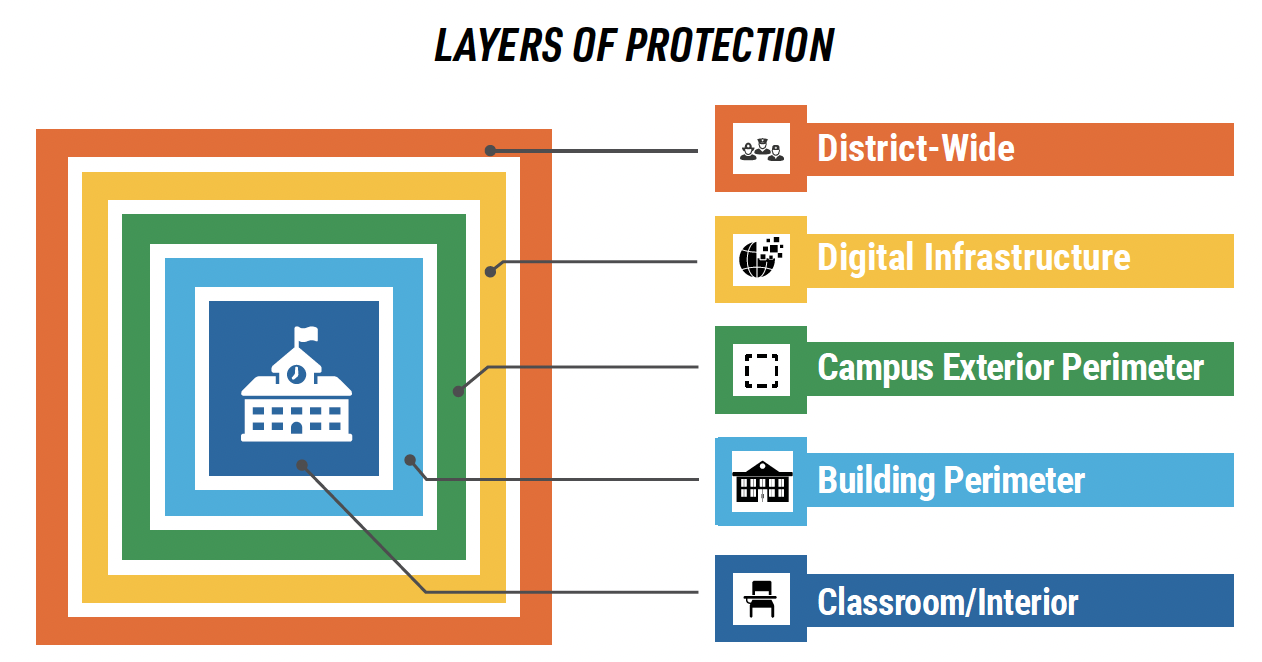What the Guidelines Cover
The primary focuses of the PASS Guidelines are physical security and life safety, and recommendations are limited to related policies, procedures, equipment and technology. Modern and effective security infrastructure is an essential element of any comprehensive school safety and security strategy, but not the only element. When other prevention efforts fail, facility security measures are critical to protection, mitigation and response. The Guidelines do not address every risk and every situation and, importantly, do not include product-specific recommendations.

Why Use the PASS Guidelines
- Support School Risk Assessments
- Develop School Safety & Security Plans
- Avoid Common School Safety & Security Pitfalls
- Inform Standards Development
- Strengthen School Grant Proposals & Bond Measures
Who the Guidelines Are For
While the PASS School Safety and Security Guidelines provide best practices designed primarily for the team responsible for the safety and security of individual schools and entire school districts, the Guidelines are also useful for interested community members, legislators, researchers and others with a focus or interest in improving K-12 school safety and security.


What’s new in the Seventh Edition PASS Guidelines?
The seventh edition release – including updates to the Safety and Security Guidelines and the School Safety and Security Checklist – improves on previous versions of the PASS guidance to make it more comprehensive, easier to use, and more reflective of K-12 schools’ evolving security needs and challenges. There are many new features in the seventh edition of the PASS Guidelines, including the following significant updates:
Introduction of a New Digital Infrastructure Layer
The new digital infrastructure layer recognizes the importance of cybersecurity and attentive management of digital systems and data. This takes a converged approach to security, dramatically expanding PASS beyond its previous primary focus on physical security.
Unification of the Property Perimeter and Parking Lot Layers Into the New Campus Perimeter Layer
The many volunteer school security experts involved with PASS recognized that these layers are interconnected and more efficiently approached from a unified safety standpoint.
Detailed Guidance on Visitor Entry
In addition to traffic-flow diagrams and example floor plans, this edition also provides extensive coverage of aspects such as visitor management processes, which can introduce vulnerability without proper attention to detail.
Greater Content on Physical Hardening
From topics like door construction and window glazings to security film and reinforcement of classroom walls, the Seventh Edition Guidelines add greater depth of content on aspects of physical hardening (using security-focused design, construction, and equipment to make the physical environment more resistant to threats) than previous editions.
Expanded Information on Panic Alarm Systems
As panic alarm systems have gained value through innovation and have continued to prove helpful in school emergencies, the newest edition adds guidance on this vital and evolving solution.
In-Depth Coverage of Door Locks and Door Devices
Properly locking doors is an essential component in a school, and this version covers the complexities of school-specific lock requirements with great nuance.
Each successive layer provides specific components to deter, detect or delay adversarial behaviors in the event that other layers are bypassed or breached.
Each layer includes basic protective elements, or components, of safety and security. The PASS Guidelines focus on the following safety and security components:
- Policies and Procedures
- People (roles and training)
- Communication
- Architectural
- Access Control
- Video Surveillance
- Detection and Alarms
- Transportation
- Cybersecurity
- Network Infrastructure
- Visitor Management
DISCLAIMER: The Safety and Security Guidelines for K-12 Schools (the “Guidelines”) are provided for informational purposes only. The individual contributors to the Guidelines, their employers, the organizations participating in the Partner Alliance for Safer Schools (PASS) and PASS itself make no warranties or guarantees regarding the information contained in the Guidelines, and expressly disclaim all liability for damages of any kind arising out of the use, reference to or reliance on the information contained in the Guidelines. The Guidelines are not a substitute for expert professional advice that may be required to address the specific facts and circumstances related to the implementation of a particular school safety and security measure or program.
